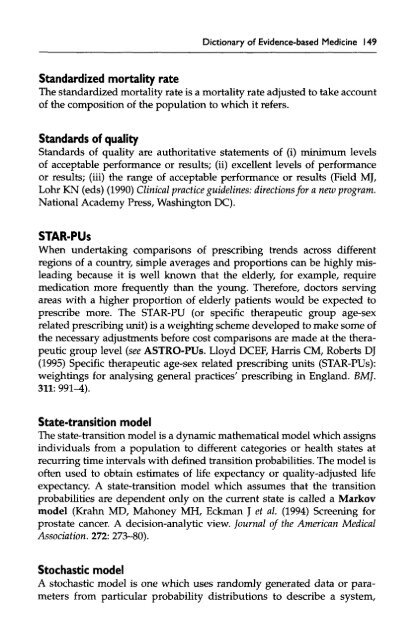Dictionary of Evidence-based Medicine.pdf
Dictionary of Evidence-based Medicine.pdf
Dictionary of Evidence-based Medicine.pdf
You also want an ePaper? Increase the reach of your titles
YUMPU automatically turns print PDFs into web optimized ePapers that Google loves.
<strong>Dictionary</strong> <strong>of</strong> <strong>Evidence</strong>-<strong>based</strong> <strong>Medicine</strong> 149<br />
Standardized mortality rate<br />
The standardized mortality rate is a mortality rate adjusted to take account<br />
<strong>of</strong> the composition <strong>of</strong> the population to which it refers.<br />
Standards <strong>of</strong> quality<br />
Standards <strong>of</strong> quality are authoritative statements <strong>of</strong> (i) minimum levels<br />
<strong>of</strong> acceptable performance or results; (ii) excellent levels <strong>of</strong> performance<br />
or results; (iii) the range <strong>of</strong> acceptable performance or results (Field MJ,<br />
Lohr KN (eds) (1990) Clinical practice guidelines: directions for a new program.<br />
National Academy Press, Washington DC).<br />
STAR-PUs<br />
When undertaking comparisons <strong>of</strong> prescribing trends across different<br />
regions <strong>of</strong> a country, simple averages and proportions can be highly misleading<br />
because it is well known that the elderly, for example, require<br />
medication more frequently than the young. Therefore, doctors serving<br />
areas with a higher proportion <strong>of</strong> elderly patients would be expected to<br />
prescribe more. The STAR-PU (or specific therapeutic group age-sex<br />
related prescribing unit) is a weighting scheme developed to make some <strong>of</strong><br />
the necessary adjustments before cost comparisons are made at the therapeutic<br />
group level (see ASTRO-PUs. Lloyd DCEF, Harris CM, Roberts DJ<br />
(1995) Specific therapeutic age-sex related prescribing units (STAR-PUs):<br />
weightings for analysing general practices' prescribing in England. BMJ.<br />
311: 991-4).<br />
State-transition model<br />
The state-transition model is a dynamic mathematical model which assigns<br />
individuals from a population to different categories or health states at<br />
recurring time intervals with defined transition probabilities. The model is<br />
<strong>of</strong>ten used to obtain estimates <strong>of</strong> life expectancy or quality-adjusted life<br />
expectancy. A state-transition model which assumes that the transition<br />
probabilities are dependent only on the current state is called a Markov<br />
model (Krahn MD, Mahoney MH, Eckman J et al. (1994) Screening for<br />
prostate cancer. A decision-analytic view. Journal <strong>of</strong> the American Medical<br />
Association. 272: 273-80).<br />
Stochastic model<br />
A stochastic model is one which uses randomly generated data or parameters<br />
from particular probability distributions to describe a system,










